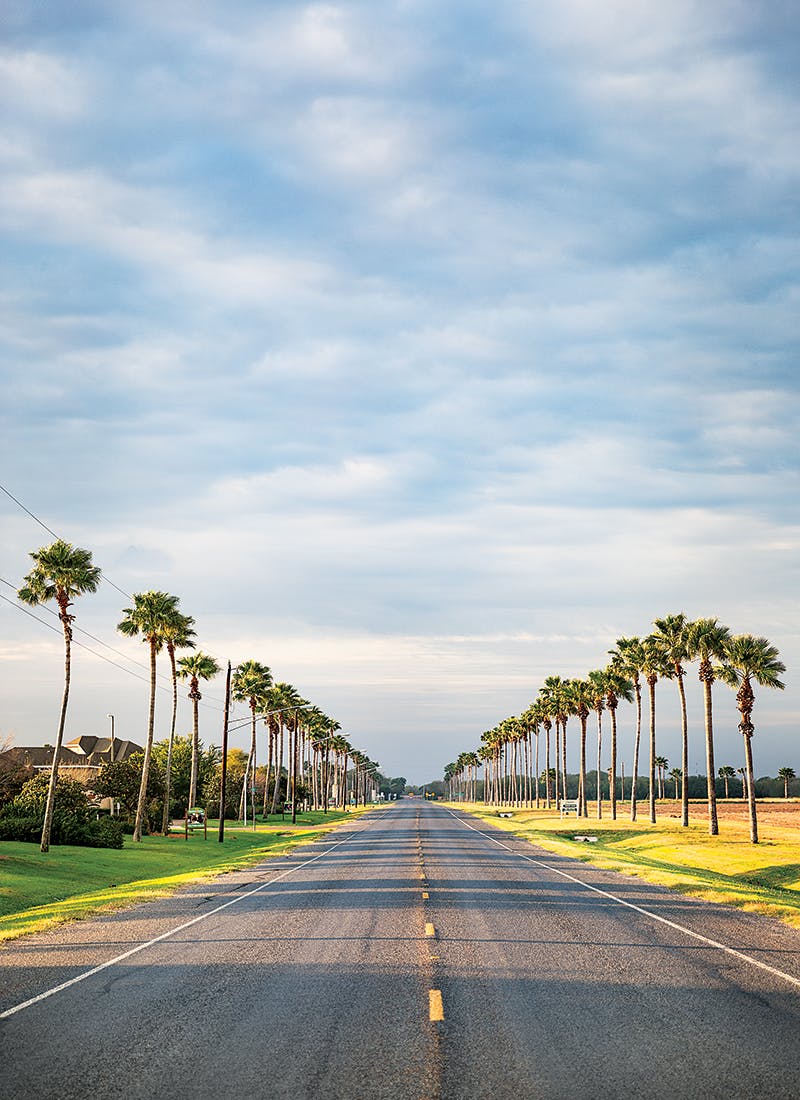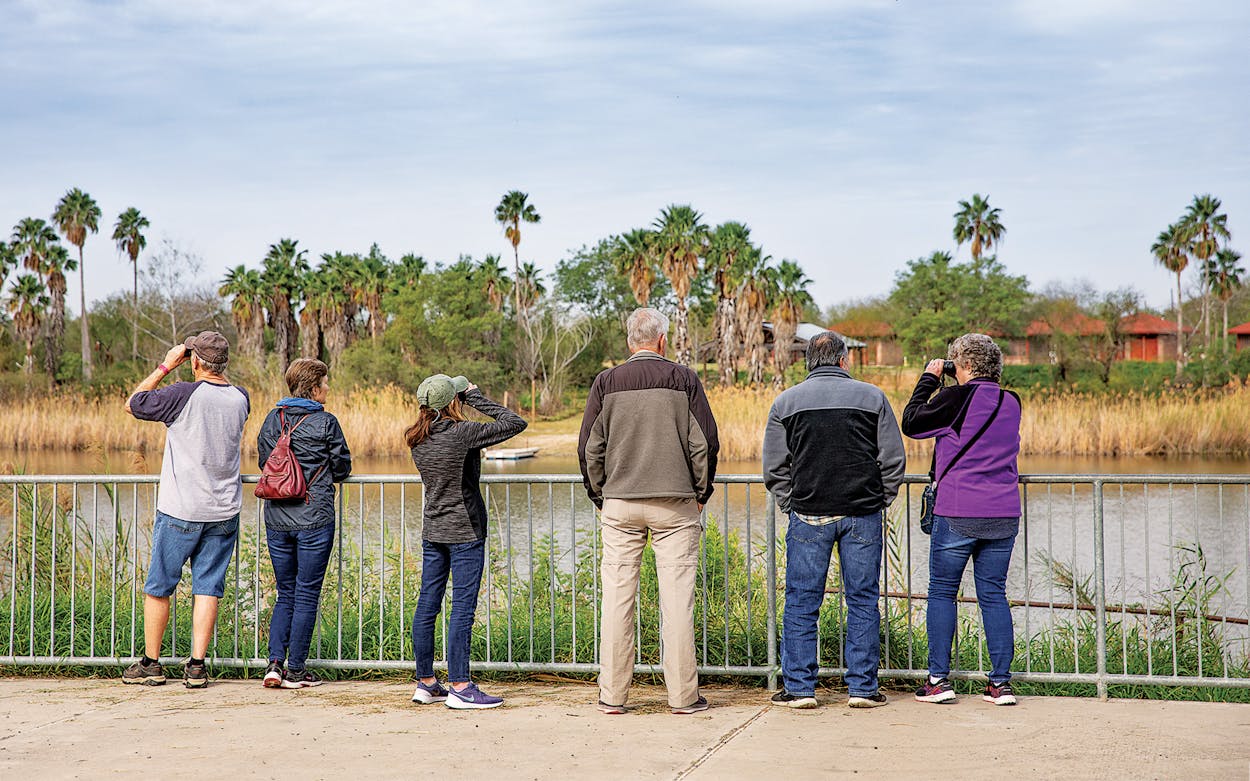I can’t believe I’m sleeping out here tonight,” Emily says, as we walk three quarters of a mile down a lonely park road in the dark, our headlamps no match for the impenetrable forest on either side. It’s the same forest we’d found so enchanting just a few hours earlier, when we’d set off on this very road to pitch our tent in a peaceful, blessedly unoccupied campground. The warm sun was then taking its leave from a sky swathed in pale blue and dusty pink, and an enthusiastic group of green jays and chachalacas was extending a loud and lusty welcome. Now it’s close to ten o’clock. We have just returned from nearby McAllen after an inadvisably hearty Mexican meal ordered from an imperfectly translated menu (for Emily, “Smoked fish with the authentic flavors of old bar,” and for me, “Fried and crunchy shrimp made with desire”), and we are further weighed down with the rest of our camping gear. The scrubby, thorny brush is alive with the sounds of rustling and cracking, and the only things our lights are able to pick up are tiny, mysterious sparkles here and there (dew? Crystalline rocks? Spider eyes?!). Finally, we seem to be alone, not only in the campground but in the entire eight hundred or so acres of Bentsen–Rio Grande Valley State Park.
We are the only folks sleeping here, at least. Southwest of Mission and northwest of Reynosa, Mexico, this little pocket of the Lower Rio Grande Valley, a region considered one of the most biologically diverse in North America, bustles day and night with both permanent residents and passers-through, the most visible of which are birds and Border Patrol. But mainly birds. Great kiskadees and altamira orioles. Vermilion flycatchers and crested caracaras. Neotropic cormorants and long-billed thrashers. The hub of the ambitiously named World Birding Center, a network of nine sanctuaries that spans the 120 miles of the Rio Grande between Roma and South Padre Island, the park sits on land that is a remnant of a floodplain forest created by a river that doesn’t flood like it used to (more frequent droughts and the 1954 erection of the Falcon Dam, about 100 miles upriver, took care of that). Nevertheless, Bentsen is a time capsule of sorts, a snapshot of what the rest of this part of South Texas would look like if it had been left in its natural state instead of being plowed over with citrus groves and golf courses and master-planned communities. Take the confluence of habitats (wetlands, dry scrub brush, riparian forest), add a convergence of four climates (temperate, desert, coastal, and subtropical), and you end up with a rare oasis that sustains, among other flora and fauna, some 360 resident and migrating bird species, including subtropical varieties rarely seen north of Mexico (more than 500 species have been recorded in the entire Lower RGV). Consider also that two of the four North American flyways—the Central and Mississippi—intersect here, and you have the Hartsfield international airport of bird migration.
Get Along, Cowbirds
Feeding stations are stocked from November to March, when local birds start to nest. Natural food, like insects, is beneficial for egg production. The park also wants to avoid attracting deadbeat cowbirds who abandon their eggs in other birds’ nests.
Migrations, authorized and otherwise, are never far from mind at Bentsen, which snuggles right up to the U.S.-Mexico border. Birders come from all over the world to train their Swarovski binoculars on the sky in hopes of spotting a Swainson’s hawk on its way from Argentina to the Great Plains. Meanwhile, the ever-present green-and-white Customs and Border Protection trucks maintain a constant watch for anyone attempting an arduous journey of their own, across terra firma that has been fought over since the 1700s.
That the park exists at all is a bit of a miracle. In his Refuge on the Rio Grande: A Regional History of Bentsen–Rio Grande Valley State Park, published in 2013, historian John J. Leffler relays a complex tale of land grants and land grabs, honorable intentions and skulduggery that takes us from eighteenth-century Spanish explorers to a 1930s-era trio of fraternal land developers whose contribution to the state was almost an afterthought and not even a sure thing at the beginning.


“There are some of the most beautiful ebony trees I’ve seen here in the valley on that stretch of the river, and I’d sure hate to take them down,” Elmer Bentsen reportedly said to his brother Lloyd (father of the future U.S. senator), as they cleared the rest of the 3,162 acres they’d purchased for $10. Settling on an idea for a park, they took a little patch that had been destined for farming and sold it, in 1944, to the Texas State Parks Board for $1, with the caveat that a park be created within three years after the end of World War II or the land be returned to the family. And it well could have been. From what he can piece together from the historical record, Leffler writes that by the early fifties, Elmer and Lloyd were frustrated by the slow pace of development, due partly to inadequate funding from the Legislature, and might have reclaimed the land had their brother Alton, who had worked for three years to get the park established (and would become its manager), not persuaded them otherwise. Alton would later suggest that he felt it was important for people to see “how the valley looked before it was settled.” Seventy-six years (and an additional 270-acre donation from other private landowners) later, we have a hard-won refuge for a wildlife community that was doing just fine before people came along. But because 95 percent of the Lower Rio Grande Valley has been cleared for development since the early twentieth century, we’ll take what we can get.
This peaceful park had a proper RV site until 2004, when Bentsen became the headquarters of the World Birding Center and banned all nonofficial vehicles, which makes sense given that large, loud, mobile, exhaust-spewing machines are not exactly conducive to birdwatching. Day visitors (some 24,000 in fiscal year 2018) leave their cars in the parking lot, and winter Texans (the Valley’s other celebrated seasonal migrants) leave their Redwoods and Phaetons in the luxury RV resort just outside the gates. Everyone explores Bentsen by walking, taking the tram (it makes the rounds to designated stops every day between 8:30 and 4:30), or riding a bicycle (bring your own or rent one from the visitors center). If you want to spend the night in the park, you will most likely have your choice (literally) of ten primitive, closely set campsites, to which the tram will deliver you and, most importantly, your stuff.
The four hiking trails are short and easy, the better to focus on the birds. The longest, the Rio Grande trail (1.8 miles round trip), takes you to the Hawk Tower, an elevated walkway to a platform above the tree line. The tower is best visited in spring and fall, during Hawk Watch, when volunteers gather to count migrating raptors like Cooper’s hawks, broad-winged hawks, and Mississippi kites as they soar atop thermals. The tiny Green Jay trail leads you along the edge of a beautiful resaca, from the Green Jay Blind to the Kingfisher Overlook, where you can scout for one of those species as well as great blue herons and double-crested cormorants. If you have no idea what you’re looking at or what you should be looking for, a visit to the park’s museum-quality Exhibit Hall or La Familia Nature Center, complete with schoolhouse-style displays and a small research library (with titles like Raptors of the World and Nesting Birds of a Tropical Frontier), should get you on track.
A sense of vulnerability is as interwoven into this park as the spiny hackberry that once sheltered visiting ocelots and jaguarundis.
Of course, the best way to get a sense of the park and its inhabitants is to take a tour with an employee or a volunteer, like John Kaye, a retiree whose elegant mien, inexhaustible knowledge, and dry wit made him the perfect escort for the leisurely Saturday morning stroll Emily and I had optimistically signed up for long before our Friday night descent into the heart of darkness (which we survived). Having been warned that sightings are never guaranteed (“On any given day, birds do what birds do,” Kaye said), Emily and I were shocked at the number of winged creatures Kaye managed to find for us: “Golden-fronted woodpecker on the suet log there.” “I’ve got an anhinga in my scope.” We saw at least twenty types of birds, from a spotted sandpiper to a magnificent gray hawk. I’ll never look at a tree canopy the same way again. Throughout the walk, Kaye fielded lofty questions from our fellow tour-takers, regarding such things as torso lengths and wingbeat speeds, while also gamely joining me at my level in one of my favorite state park pursuits, “What Shat That?” (Lots of seeds? Probably javelina. Pointed at the tip? Bobcat. Kind of furry? Coyote.)

Earlier that morning, we’d emerged from our lonely little tent in a grove of ebony trees to what sounded like a handbell rendition of “The Star-Spangled Banner,” perhaps coming from the veterans’ cemetery nearby. We felt a little silly about our apprehension the night before, but, then, a sense of vulnerability is as interwoven into this park as the spiny hackberry that once sheltered visiting ocelots and jaguarundis. Last year U.S. representative Henry Cuellar, a Democrat from Laredo, successfully secured refuge for this refuge, preventing the construction of border wall fencing that would have gone right through the middle of the park, as well as through a few other environmentally and historically sensitive sites nearby, like the National Butterfly Center and La Lomita Chapel (see sidebar). But the Lower Rio Grande Valley National Wildlife Refuge has not been so lucky. Made up of 135 discrete tracts of land purchased by the U.S. Fish and Wildlife Service (its “string of pearls”), the refuge is a nearly 105,000-acre “wildlife corridor” that follows the last 275 miles of the Rio Grande before it meets the Gulf. Because the land is owned by the federal government, about 18 miles of border wall are likely to go up within the refuge unless Cuellar or other officials can secure more protection. Several federal laws enacted to protect the already fragile area, like the Endangered Species Act and the Migratory Bird Conservation Act, have already been suspended. The birds, of course, have freedom of movement we can only dream of. But that doesn’t mean much when they have nowhere to land. As for the wild cats, estimates suggest there are no more than 120 ocelots in Texas. The jaguarundi is believed to be extinct here.
That night, we eat a sensible dinner and slip into our sleeping bags to a soundtrack of loud, lively, surprisingly comforting conjunto music coming from somewhere in the vicinity. As a helicopter passes overhead, we lie on ground that we’ve been told is studded with sensors and talk about how so many things are connected and interdependent; of what we lose, knowingly or not, when we destabilize delicate places; and of fragile creatures undertaking perilous passages on a wing and a prayer.
This article originally appeared in the March 2020 issue of Texas Monthly with the headline “Eyes on the Skies.” Subscribe today.
- More About:
- Parks & Recs









